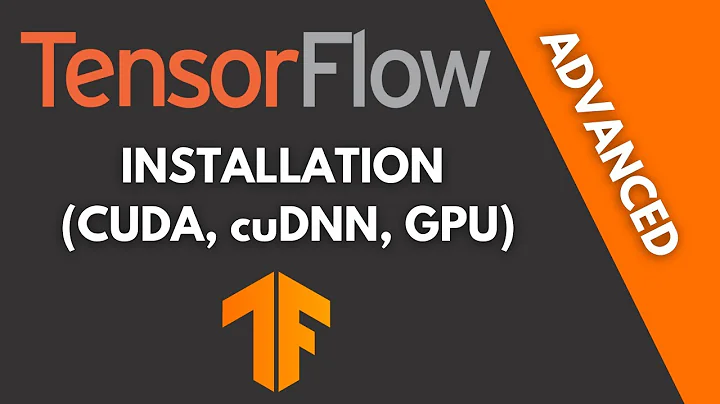CUDA kernel failed : no kernel image is available for execution on the device, Error when running PyTorch model inside Google Compute VM
I resolved this in the end by manually deleting all the folders except for "src" in the folder containing setup.py
Then rebuilt the docker image
Then when building the image I ran TORCH_CUDA_ARCH_LIST="6.1" python setup.py install, to install the cuda extensions targeting the correct compute capability for the GPU on the VM
and it worked!
I guess just running setup.py without deleting the folders previously installed doesn't fully overwrite the extension
Related videos on Youtube
user3882675
Updated on June 04, 2022Comments
-
user3882675 almost 2 years
I have a docker image of a PyTorch model that returns this error when run inside a google compute engine VM running on debian/Tesla P4 GPU/google deep learning image:
CUDA kernel failed : no kernel image is available for execution on the deviceThis occurs on the line where my model is called. The PyTorch model includes custom c++ extensions, I'm using this model https://github.com/daveredrum/Pointnet2.ScanNet
My image installs these at runtime
The image runs fine on my local system. Both VM and my system have these versions:
Cuda compilation tools 10.1, V10.1.243
torch 1.4.0
torchvision 0.5.0
The main difference is the GPU as far as I'm aware
Local:
+-----------------------------------------------------------------------------+ | NVIDIA-SMI 435.21 Driver Version: 435.21 CUDA Version: 10.1 | |-------------------------------+----------------------+----------------------+ | GPU Name Persistence-M| Bus-Id Disp.A | Volatile Uncorr. ECC | | Fan Temp Perf Pwr:Usage/Cap| Memory-Usage | GPU-Util Compute M. | |===============================+======================+======================| | 0 GeForce GTX 960M Off | 00000000:01:00.0 Off | N/A | | N/A 36C P8 N/A / N/A | 361MiB / 2004MiB | 0% Default | +-------------------------------+----------------------+----------------------+VM:
+-----------------------------------------------------------------------------+ | NVIDIA-SMI 418.87.01 Driver Version: 418.87.01 CUDA Version: 10.1 | |-------------------------------+----------------------+----------------------+ | GPU Name Persistence-M| Bus-Id Disp.A | Volatile Uncorr. ECC | | Fan Temp Perf Pwr:Usage/Cap| Memory-Usage | GPU-Util Compute M. | |===============================+======================+======================| | 0 Tesla P4 Off | 00000000:00:04.0 Off | 0 | | N/A 42C P0 23W / 75W | 0MiB / 7611MiB | 3% Default |If I ssh into the VM
torch.cuda.is_available()returnstrueTherefore I suspect it must be something to do with the compilation of the extensions
This is the relevant part of my docker file:
ENV CUDA_HOME "/usr/local/cuda-10.1" ENV PATH /usr/local/nvidia/bin:/usr/local/cuda-10.1/bin:${PATH} ENV NVIDIA_VISIBLE_DEVICES all ENV NVIDIA_DRIVER_CAPABILITIES compute,utility ENV NVIDIA_REQUIRE_CUDA "cuda>=10.1 brand=tesla,driver>=384,driver<385 brand=tesla,driver>=396,driver<397 brand=tesla,driver>=410,driver<411 brand=tesla,driver>=418,driver<419" ENV FORCE_CUDA=1 # CUDA 10.1-specific steps RUN conda install -c open3d-admin open3d RUN conda install -y -c pytorch \ cudatoolkit=10.1 \ "pytorch=1.4.0=py3.6_cuda10.1.243_cudnn7.6.3_0" \ "torchvision=0.5.0=py36_cu101" \ && conda clean -ya RUN pip install -r requirements.txt RUN pip install flask RUN pip install plyfile RUN pip install scipy # Install OpenCV3 Python bindings RUN sudo apt-get update && sudo apt-get install -y --no-install-recommends \ libgtk2.0-0 \ libcanberra-gtk-module \ libgl1-mesa-glx \ && sudo rm -rf /var/lib/apt/lists/* RUN dir RUN cd pointnet2 && python setup.py install RUN cd ..I have already re-running this line from ssh in the VM:
TORCH_CUDA_ARCH_LIST="6.0 6.1 7.0" python setup.py installWhich I think targets the installation to the Tesla P4 compute capability?
Is there some other setting or troubleshooting step I can try?
I didn't know anything about docker/VMs/pytorch extensions until a couple of days ago, so somewhat shooting in the dark. Also this is my first stackoverflow post, apologies if I'm not following some etiquette, feel free to point out.
-
Alexandre about 4 yearsI would need to know how you are running docker, is it on a single instance, or a cluster? Did you get the Image from the Docker repository? I also need to know if you got your CUDA driver from the NVIDIA dev site? Or was the driver included in the image?
-





